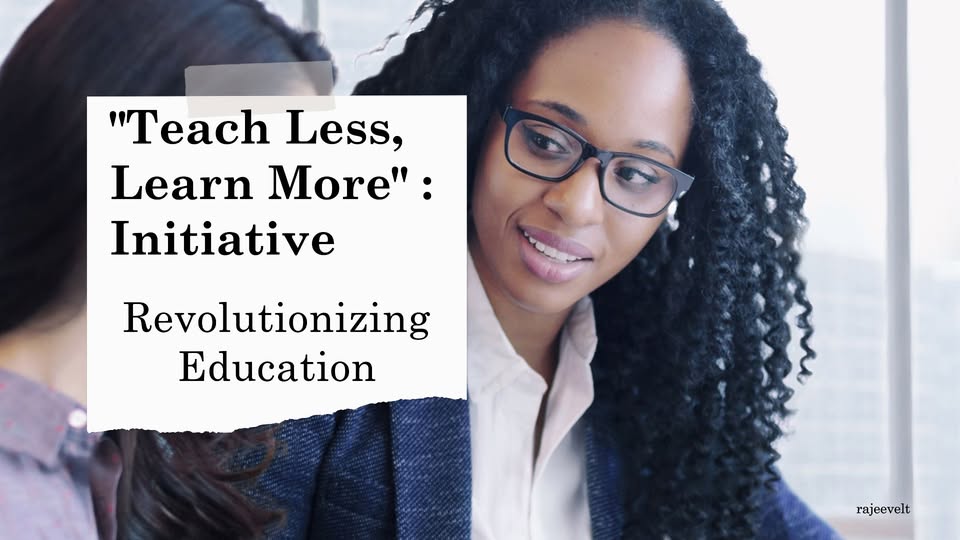
Chapter 4
Implementing the “Teach Less, Learn More” Philosophy in K-12 Classrooms
Introduction
Implementing the “Teach Less, Learn More” (TLLM) philosophy requires a transformative approach to teaching and learning. It involves a shift from traditional, teacher-centric methods to innovative, student-centered practices.
Step 1: Redesigning the Curriculum
The first step in implementing TLLM is restructuring the curriculum to focus on essential knowledge and skills. Educators must identify core concepts and reduce redundant or peripheral content. This ensures that students have adequate time to explore topics in depth.
The teachers can focus on critical periods like the Industrial Revolution in history classes, rather than covering every event superficially. Teacher analyses its causes, processes, and outcomes through various lenses, students develop a holistic understanding.
Research by Wiggins and McTighe (2005) in Understanding by Design emphasizes the importance of focusing on “enduring understandings” to deepen learning.
Step 2: Adopting Differentiated Instruction
TLLM succeeds when teachers use differentiated instruction to cater to diverse learning styles and abilities. When teachers design tailored lessons to meet individual needs, they ensure every student is actively engaged and progressing.
Implementation Strategies:
- Use pre-assessments to determine students’ prior knowledge.
- Create tiered assignments that offer varying levels of complexity.
- Incorporate multimodal teaching resources, such as videos, games, and hands-on activities.
Advanced learners might design a model of the water cycle in a science class, while others focus on observing and describing its basic processes. Tomlinson (2001) highlights that differentiated instruction boosts student engagement and achievement in mixed-ability classrooms.
Step 3: Encouraging Collaborative Learning
Collaboration nurtures peer-to-peer learning, a hallmark of the TLLM philosophy. Group activities encourage students to share ideas, solve problems collectively, and learn from diverse perspectives.
Classroom Applications:
- Conduct group projects on real-world issues, such as designing eco-friendly school initiatives.
- Use peer teaching, where students explain concepts to their classmates.
- Encourage debate and discussion to develop critical thinking.
Students could work in teams to research and present solutions to urbanization challenges in megacities in a geography lesson. Johnson, Johnson, and Smith (1998) assert that cooperative learning improves interpersonal skills and deepens subject comprehension.
Step 4: Integrating Technology
Technology plays a pivotal role in implementing TLLM by personalizing learning and providing interactive educational experiences. Digital tools enable self-paced learning and access to global resources.
Tools and Techniques:
- Use platforms like Google Classroom for assignments and feedback.
- Introduce virtual reality for immersive experiences, such as exploring historical landmarks.
- Leverage AI-driven tools like adaptive quizzes that adjust to student performance.
Students can use language-learning apps like Duolingo to practice vocabulary and grammar independently in a language class. The International Society for Technology in Education (ISTE, 2021) highlights that technology integration enhances engagement and achievement when associated with pedagogical goals.
Step 5: Promoting Inquiry-Based Learning
Inquiry-based learning encourages students to ask questions, investigate answers, and construct knowledge through exploration. This approach shifts the focus from rote memorization to critical thinking and problem-solving.
Steps for Implementation:
- Pose an open-ended question or problem.
- Guide students in researching and experimenting.
- Facilitate reflection and sharing of findings.
The students might investigate the impact of local environmental changes on biodiversity in a biology class, by conducting field studies and presenting their conclusions. A study by Hmelo-Silver et al. (2007) found that inquiry-based learning significantly enhances critical thinking and retention.
Step 6: Building a Positive Classroom Culture
A supportive and inclusive classroom environment is vital for the success of TLLM. Students need to feel safe, respected, and encouraged to express themselves.
Strategies:
- Establish clear expectations and routines.
- Celebrate student successes, both big and small.
- Incorporate social-emotional learning (SEL) into daily activities.
Morning circles where students share their thoughts and feelings help build community and trust. CASEL (2019) highlights that SEL improves academic performance and emotional well-being.
Step 7: Continuous Professional Development
Teachers are the driving force behind TLLM. Ongoing professional development equips them with the skills and knowledge to implement innovative strategies effectively.
Approaches:
- Conduct workshops on active learning and technology integration.
- Encourage peer observations and feedback.
- Provide access to online courses and teaching resources.
A professional learning community (PLC) where teachers collaboratively plan lessons and share best practices promotes continuous improvement. Darling-Hammond (2017) found that sustained, collaborative professional development leads to significant gains in teaching effectiveness.
Conclusion
It requires deliberate planning, innovation, and a commitment to student-centered learning in implementing the “Teach Less, Learn More” philosophy in K-12 classrooms. Schools can create an educational environment that prioritizes meaningful and impactful learning while redesigning curricula, adopting differentiated instruction, encouraging collaboration, integrating technology, promoting inquiry-based learning, building positive classroom cultures, and investing in teacher development. These steps ensure that students are not just passive recipients of knowledge but active participants in their educational journey.

References
- Wiggins, G., & McTighe, J. (2005). Understanding by Design. ASCD.
- Tomlinson, C. A. (2001). How to Differentiate Instruction in Mixed-Ability Classrooms. ASCD.
- Johnson, D. W., Johnson, R. T., & Smith, K. A. (1998). Cooperative Learning Returns to College: What Evidence Is There That It Works?
- Hmelo-Silver, C. E., Duncan, R. G., & Chinn, C. A. (2007). Scaffolding and Achievement in Problem-Based and Inquiry Learning: A Response to Kirschner, Sweller, and Clark (2006).
- ISTE. (2021). Standards for Educators.
- CASEL. (2019). Social and Emotional Learning (SEL) Framework.
- Darling-Hammond, L., Hyler, M. E., & Gardner, M. (2017). Effective Teacher Professional Development. Learning Policy Institute.


